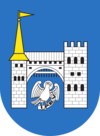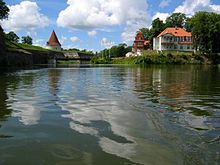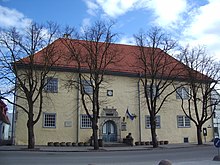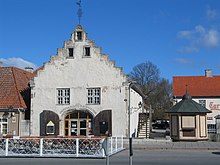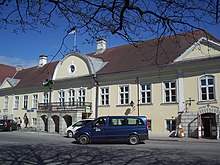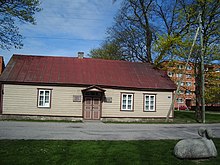Kuressaare
| Kuressaare | |||
|
|||
| State : |
|
||
| Circle : |
|
||
| Founded : | 1563 (town charter) | ||
| Coordinates : | 58 ° 15 ′ N , 22 ° 29 ′ E | ||
| Height : | 5 m | ||
| Area : | 14.95 km² | ||
| Residents : | 13,339 (January 1, 2016) | ||
| Population density : | 892 inhabitants per km² | ||
| Time zone : | EET (UTC + 2) | ||
| Telephone code : | (+372) 045 | ||
| Community type: | city | ||
| Structure : | 15 districts | ||
| Mayor : | Madis Kallas
(independent) |
||
| Postal address : | Tallinna 10 93813 Kuressaare |
||
| Website : | |||
| Patron saint : | Evangelist John | ||

|
|||
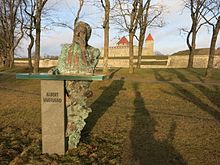
Kuressaare ( German Arensburg ) is the only city on the largest Estonian island Saaremaa ( Ösel ). It is located directly on the Baltic Sea on the south coast of the island, between the bays Sepamaa laht in the east and Kuressaare laht and Linnulaht in the west.
Kuressaare is both the main town and administrative seat of the Saare district ( Saare maakond ) and the rural community of Saaremaa, which was founded in 2017 .
Surname
The historical German name of the city, Arensburg ( Low German "Adlerburg"), is probably derived from the eagle on the city arms. He symbolizes the evangelist John .
Kuressaare's landmark is the medieval bishop's castle Arensburg , located directly on the water . It was first mentioned in a document in 1398 under the name Arnsborch Castle.
The Estonian-speaking name of the city means crane island . It is possibly derived from the misunderstood coat of arms. During the Soviet occupation of Estonia , Kuressaare was called Kingissepa from 1952 to 1988 . It was named after the Estonian Bolshevik Viktor Kingissepp , who was born on Saaremaa and was executed in 1922.
history
middle Ages
The island of Saaremaa was conquered in 1227 by the Order of the Brothers of the Swords under Volkwin von Naumburg to Winterstätten . A short time later it fell under the rule of the Teutonic Order after it had united with the Order of the Brothers of the Sword.
Today's city was built around a bishop's castle ( arx aquila ). It was the residence of the bishops of the Diocese of Ösel-Wiek . The settlement itself has been documented since 1424.
Danish rule
In 1559, during the Livonian War , the last Prince-Bishop of Ösel and first Protestant at this post, Magnus of Denmark , sold Arensburg to Denmark. In 1563 the place received city rights based on the model of Riga .
Swedish rule
In 1645 Arensburg fell to the Kingdom of Sweden in the Treaty of Brömsebro . From the end of the 16th to the end of the 17th century, Kuressaare was an important trading town in the region. During this time, numerous buildings were built in the baroque old town. This was followed by an economic decline for almost 150 years.
Russian rule
In 1710, Arensburg was burned down by Russian troops in the Great Northern War . With the Peace of Nystad (1721) it fell to the Russian Empire and in 1783 became the capital of the district (Ujesd) Ösel in Livonia's governorate . In the same year, Balthasar Freiherr von Campenhausen was appointed lieutenant governor of Livonia and director of the Livonian camera court, a position he held until 1797. In Arensburg, Campenhausen had entire streets demolished and modernized, took care of street signs and cleaning, ordered the removal of garbage dumps, abolished the flammable thatched roofs that were customary up to that time and suggested the establishment of the Arensburg Weekly or Intelligence Gazette . "He was always restless on his bikes or in the saddle," said contemporary witnesses, and it was not uncommon for the baron to visit his auditors without prior notice. Campenhausen's zeal owed the then backward and underdeveloped Ösel a comparatively modern infrastructure. The baron also gave the social life in the remote province unusual impulses: "He formed a small court where there was no lack of intrigues. With the glaring French language, which he loved and promoted, glitzy French customs and Morality in this country, in which until then strict respectability had prevailed. " Ladies had to appear in a "blue and white uniform" designed by the baron. From October 2, 1785, Campenhausen held a "men's club" every Thursday in his property, which was decorated with Dutch tiles and statues, followed by a "dance club" every Wednesday in 1786. In 1787 he set up a "school theater" in the Arensburg town hall, the performances of which, including pieces by Gotthold Ephraim Lessing , began at 5 pm all year round. At the beginning of each month, a "musical lovers' society" scheduled concerts. After a reading circle was founded in 1785, the first lending library followed in 1791.
spa
With the establishment of medicinal sea and mud baths, the city developed into a popular recreational and health resort in Livonia and beyond from the 1840s . The reputation of the city as a health resort spread throughout the entire Tsarist empire, especially through the Russian surgeon Nikolai Pirogow , who sent numerous wounded from the Crimean War (1853–1856) to Kuressaare for medical rehabilitation:
- The mud baths had become fashionable, swimming for health purposes, promenading and listening to music - the western part of the city was entirely devoted to the needs of its guests, who flocked here from all parts of the tsarist empire in the summer. The newly laid out promenade, the city park and the many baths provided relaxation. Historicism influenced by Russian wooden architecture spread in the reading houses, cafes, guesthouses and in the Kurhaus . These graceful looking wooden buildings formed an attractive contrast to the massive and bulky looking old town houses; With their attention to detail and intimacy, the preserved ones still convey an impression of ornate lightness.
Republic of Estonia
With the independence of the Republic of Estonia in 1918, tourist contacts between Kuressaare and the Latvian capital Riga, now located abroad, declined slightly. Nevertheless, Kuressaare retained its status as a health resort and recreation area. Even during the Soviet occupation of Estonia, Kuressaare remained an attraction for those seeking relaxation.
At the end of the 20th century, after Estonian independence was regained, Kuressaare flourished again as a health resort. Numerous modern spa hotels , beauty salons and wellness offers were created , which attract numerous holidaymakers, including many visitors from Finland , especially in summer .
The city is also the political, cultural and economic center of the Saare district. It houses a cultural center, a grammar school, the island's central library, the district hospital built by Edgar Kuusik in 1940 and, since 1999, a professional city theater. In 1999 the beach and the marina were reopened. The Kuressaare Linnastaadion is the home stadium of the FC Kuressaare football club .
Culture and sights
Episcopal Castle
The Kuressaare Episcopal Castle is one of the best preserved medieval castles in the Baltic States . The imposing structure made of dolomite blocks has retained its original appearance to this day. Its five-story, 29-meter-high tower, the "Lange Herrmann", is characteristic. Around the bishop's castle there is a sweeping moat filled with water .
Today the castle houses a museum about the island history of Saaremaa.
town hall
During the Swedish rule, from 1654 to 1670, the town hall was built in the Baroque style. The initiator of the simple structure with its strict architecture was the Swedish statesman Magnus Gabriel De la Gardie . The portal bears the Latin inscription "Semper officio fungitur utilitati hominum cosulens et societati" and the year 1670, as well as the city's coat of arms. The house was badly damaged in 1710 during the Northern War , but was rebuilt between 1786 and 1787 .
In 1847 a neo-Gothic tower was added to the town hall. It was demolished in 1931 due to wood damage.
The town's tourist information center is now located on the ground floor of the town hall; the city council meets on the upper floor. The town hall also houses the largest ceiling painting in Estonia.
On the nearby main town square, a memorial commemorates those who died in the Estonian War of Independence against Soviet Russia (1918–1920). It was created in 1928 by the Estonian artist Amandus Adamson . The monument was destroyed during the Soviet occupation of Estonia, but rebuilt after regaining independence.
Weighing house
Opposite the town hall is the so-called weighing house (vaekoda) from 1663. The official weights and measures were kept in it. The building is the only surviving structure of its kind in present-day Estonia.
Knighthood House
The later knighthood house was completed in the second half of the 18th century. At the beginning of the 19th century it was acquired by the Oesel knighthood from the German Baltic von Dellingshausen family . A striking feature of the facade is the portico made of dolomite with its balcony. The house was restored in 1976 according to an engraving by the artist Friedrich Sigismund Stern in 1859.
Today the Saare district administration is housed in the building .
Laurentiuskirche
The Evangelical Lutheran Laurentius Church was built in 1733. It was built on the site of a church built in the 1630s that fell victim to the ravages of the Northern War in the early 18th century . Some of the original walls are still preserved in the current church walls.
In 1828 the church burned down, but was rebuilt under the direction of the architect Heinrich Löwener. This simply held nave is dominated on the west side of a square tower, a classicist spire adorns. The three years on the weather vane mark the construction of the baroque tower spire (1774), the restoration of the church (1836) and the renovation of the tower roof (1933).
The single-nave church has largely retained its original, unpretentious furnishings, including a natural baptismal font from the southwestern village of Anseküla, probably from the 14th century .
The altar painting “ Golgotha ” from 1836 is the work of the Dresden- born painter Carl Sigismund Walther (1783–1866). The pulpit with its round pillar made of dolomite stone dates from the same year . The organ is a work from the workshop of Wilhelm Sauer from Frankfurt (Oder) . Today's church windows were created in 2001 by the Estonian artist Urmo Raus (* 1969).
The rectory is not far from the church . The elongated building was erected before 1710 in the Baroque style. The Baltic German theologian and linguist Eberhard Gutsleff the Younger lived there from 1738 until his arrest by the tsarist authorities in 1747 .
Nikolaikirche
Kuressaare's first Orthodox church was built from wood in 1748. Today's three-aisled Orthodox Church of St. Nicholas was built between 1786 and 1798 on the basis of an ukase from Empress Catherine II on the site of the former church. It was consecrated on September 22, 1790.
The building with its pointed west tower has a Latin cross floor plan . The interior of the church with its vaults is colorful and splendid. The iconostasis dates from the turn of the 18th and 19th centuries.
The early classical wrought iron gate to the churchyard was built in 1840 at the instigation of the church elder Sofoni Cholostow and is considered the most beautiful gate in the city.
The Nikolaikirche is now subordinate to the Estonian Apostolic Orthodox Church (EAÕK).
Kurhaus and city park
The city's Kurhaus, which opened in 1889, was extensively renovated in 1988. Today it houses a restaurant, among other things. Adjacent to the Kurhaus is the 17-hectare Kuressaare City Park, which was created in the 1860s and which also houses the singer's stage.
The city park was built on the site of the old Kuressaare cemetery. A small memorial made of old grave slabs reminds of him, which quotes in German the Friedrich Schiller , who was already valued in Estonia and Livonia during his lifetime : "Do good, you nourish divine plants for humanity."
Aavik Museum
A museum is dedicated to the Aavik family. The linguist Johannes Aavik (1880–1973), who made a significant contribution to the creation of the modern Estonian language, lived and worked in the house . In addition, part of the permanent exhibition is devoted to the life and work of music teacher and organist Joosep Aavik (1899–1989).
traffic
In the second half of the 19th century, when spa tourism picked up speed in Kuressaare, a regular steamboat connection was established between Kuressaare and the Livonian capital Riga . In 1894 Kuressaare received a new port in the northern district of Roomassaare .
Kuressaare also has a small airport with two runways. From there there are regular flights to Tallinn and the island of Ruhnu .
sons and daughters of the town
- Hannibal Sehested (1609–1666), Danish-Norwegian statesman
- Georg von Bradke (1796–1862), officer and curator of the University of Dorpat
- Richard Maack (1825–1886), naturalist, educator and explorer
- Eugen Dücker (1841–1916), landscape painter
- Richard Otto Zöpffel (1843–1891), theologian and church historian
- Alexander Peter Eduard von Buxhoeveden (1856–1919), landowner and politician
- Heinrich Oswald von Saß (1856–1913), painter
- Oskar Masing (1874–1947), philologist
- Helene Aeckerle (1875–1940), German author and translator
- Axel von Freytagh-Loringhoven (1878–1942), international lawyer and politician
- Erwin Rahr (1880–1919), Russian officer
- Paul Bassen-Spiller (1892–1962), colonel of Baltic-German origin in the Estonian military
- Carl Mumme (1898–1983), physician, honorary professor at the University of Hamburg, chief physician at the General Hospital Hamburg-Bergedorf
- Louis I. Kahn (1901–1974), American architect, town planner and university professor
- Harri Haamer (1906–1987), clergyman and writer
- Karl-Georg von Stackelberg (1913–1980), market researcher, author and consultant
- Bernd Freytag von Loringhoven (1914–2007) General of the Bundeswehr and Deputy Inspector General
- Erik Boettcher (1919–1992), professor of economics at the Stuttgart-Hohenheim Agricultural University
- Ivar Karl Ugi (1930-2005), chemist
- Tiiu Aro (* 1952), politician and doctor
- Jüri Pihl (1954–2019), politician
- Maria Faust (* 1979), jazz saxophonist and band leader
- Mihkel Aksalu (* 1984), football player
- Tiidrek Nurme (* 1985), athlete
- Mihkel Räim (* 1993), racing cyclist
Town twinning
Kuressaare currently has eight city partnerships:
-
 Raseborg (since 1988)
Raseborg (since 1988) -
 Rønne (since 1991)
Rønne (since 1991) -
 Mariehamn (since 1991)
Mariehamn (since 1991) -
 Skövde (since 1993)
Skövde (since 1993) -
 Sastamala (since 1994)
Sastamala (since 1994) -
 Turku (since 1996)
Turku (since 1996) -
 Talsi (since 1998)
Talsi (since 1998) -
 Kuurne (since 1998)
Kuurne (since 1998)
Web links
- Official website, German
- Description on eestigiid.ee (Estonian)
- Entry in Eesti Entsüklopeedia (online version)
Individual evidence
- ↑ Thorkild Kjaergaard: Castles around the Baltic Sea: the illustrated guide . Castle Museum, 1994, ISBN 978-83-8620603-2 , pp. 64 ( google.com [accessed June 4, 2012]).
- ↑ Martin Körber: Oesel once and now. Volume 1, Arensburg 1887, p. 168.
- ↑ Martin Körber: Oesel once and now. Volume 1, Arensburg 1887, p. 122.
- ↑ Martin Körber: Oesel once and now. Volume 1, Arensburg 1887, p. 135.
- ↑ Indrek Rohtmets: Kultuurilooline Eestimaa. Tallinn 2004, ISBN 9985-3-0882-4 , p. 37.
- ^ Thea Karin: Estonia. Cultural and scenic diversity in a historical borderland between east and west. (= DuMont art and landscape guide ). Cologne 1994, ISBN 3-7701-2614-9 , p. 312f.
- ↑ a b Kuressaare Laurentiuse kirik. ( viroweb.ee ( memento from November 29, 2011 in the Internet Archive ))
- ↑ Ivar Sakk: Eesti kirikud. Teejuht. Tallinn 2014, p. 337.
